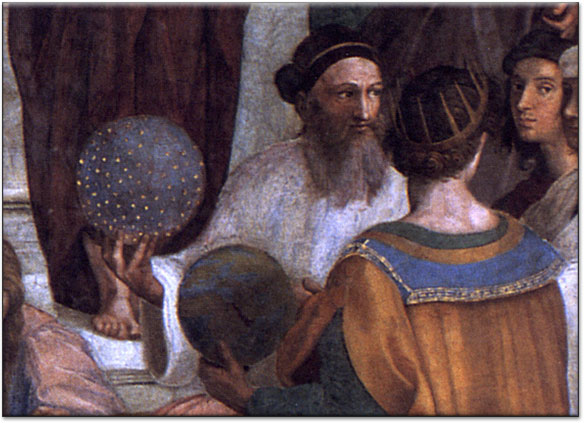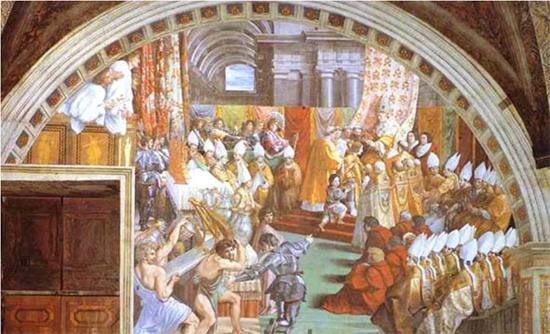The Rise of Renaissance Perspective
| |
|
|
|
|
 |
|
|
Fig. 11. A sphere projects to the eye in a circular cone from its tangent boundary; this cone must have an elliptical intersection with the picture plane if the cone is at an angle to the line of sight.
|
The
visual projection of a sphere at the eye is never foreshortened but
always a circle, defining a right circular cone with its point at the
eye’s nodal point and its base around the tangent boundary of
the sphere. (The tangent boundary is the line on the sphere where straight
lines from the eye just graze the sphere). This circular projection
makes it easy to apply the venerable Theory of Conic Sections (which
date to Menaechmus and Appollonius of Perga in Greece of the 4th century
BC) for the perspective projection of the sphere onto a picture plane.
Projection to the picture plane corresponds to the intersection of the
cone by this plane, which always forms an ellipse (assuming that the
intersecting plane lies at an angle outside the range of angles formed
by the cone). Thus, whatever angle is chosen for the picture plane,
the intersection is always an ellipse of some orientation and elongation,
until the angle becomes so extreme that the projection plane enters
the range spanned by the cone.
 |
|
Fig. 12. Detail of Ptolemy and Zoraster
holding the earthly and heavenly spheres. Notice that Raphael has painted
them almost circular despite their oblique angle of view from the center
of projection.
|
 |
The classic example of the incorrect projection of a sphere is provided
by Raphael’s ‘School of Athens’, where Zoroaster is shown
holding the sphere of the heavens while Ptolemy holds the sphere of the
earth. As painted (Fig. 12), both spheres appear perfectly circular, which
has been considered to be geometrically incorrect because they should have
projected elliptically as described by Pirenne (1947). However, at the appropriate
viewing distance of 9 m, the spheres are viewed at an angle of only 16º
away from the central vanishing point, which implies that the ellipses should
be only about 4% wider than their height. This small deviation from circularity
is hard to measure within the accuracy afforded by the paint strokes, and
is close to the limit of human discrimination of spherical distortion under
optimal conditions (Regan & Hamstra, 1992). The circular approximation
would, in any case, have been much easier to define on the wet plaster of
the fresco technique, so it seems to be a reasonable compromise on Raphael’s
part.
 |
| Fig. 13. Raphael’s ‘Coronation
of Charlemagne by Pope Leo III is one of the only paintings of the
Renaissance to employ an oblique perspective view. |
 |
The next room of the Stanze gives us insight into another remarkable feature of the Renaissance – a pronounced lack of oblique perspective constructions. Almost all paintings from 1400-1650 are in one-point perspective, with only a single vanishing point and other parallels square to the canvas. In a few cases, painters such as Masolino, Mantegna, Perugino, Leonardo and Titian included one object in one of their paintings with oblique angles, almost as though they were dipping their toe in the water but reluctant to commit to such a radical departure from universal practice. There is a corresponding example in Raphael’s ‘School of Athens’, in the drafting table at which Democritus is seated in the foreground. The perspective construction of this table is analyzed in Fig. 7. Within itself, it is well-conceived, with the vanishing points of the two sides having a convincing convergence at the eye height defined by the central vanishing point. If this were the sole set of obliques, the perspective construction would be perfect. Unfortunately, however, the squares on the floor define another set of obliques that converge with a different separation. (The rule of perspective is that all such pairs of orthogonal vanishing points should project at a separation of 90º at the eye, i.e., at roughly equal separations until the angle of orientation is extreme.) One might think that such subtleties of construction would be of no consequence within such an extended construction. It is obvious, however, that the drafting table looks slanted upward, as though it is in the process of landing on the ground. The subtle construction error made by Raphael here results in a significant perceptual dissonance of the depth interpretation.
